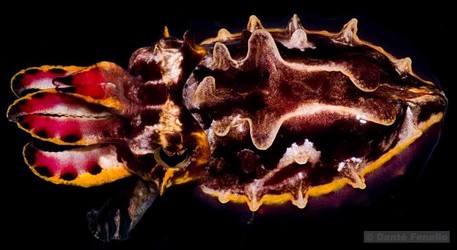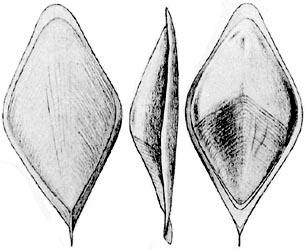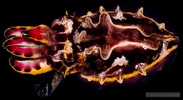Metasepia
Katharina M. Mangold (1922-2003) and Richard E. Young- Metasepia pfefferi
- Metasepia tullbergi
Introduction
These small sepiids look much like other members of the family but they differ in having a reduced cuttlebone.
Brief diagnosis:
A sepiid ...
- with cuttlebone restricted to anterior 75% of mantle.
Characteristics
- Funnel
- Funnel component of locking apparatus with pit-like depression at midpoint of groove.
- Funnel component of locking apparatus with pit-like depression at midpoint of groove.
- Mantle
- Mantle nearly as broad as long.
- Posterior gland and pore absent.
- Shell
- Cuttlebone 75-85% of mantle in length; located in anterior part of mantle.
- Cuttlebone with rhomboidal shape.
Distribution
Sandy bottom communities in the Indo-Malayan subregion of the Indo-West Pacific region (Nesis, 1982/7).
References
Adam, W. and W. J. Rees. 1966. A review of the cephalopod family Sepiidae. Sci. Rep. John Murray Exped. 11: 1-165.
Khromov, D. N., C. C. Lu, A. Guerra, Zh. Dong and S. v. Boletzky. 1998. A synopsis of Sepiidae outside Australian waters. Smithson. Contr. Zool., 586: 77-156.
Lu, C. C. A synopsis of Sepiidae in Australian waters. 1998. Smithson. Contr. Zool., 586:159-190.
Sasaki, M. 1929. A Monograph of the Dibranchiate Cephalopods of the Japanese and Adjacent Waters. Journal of the College of Agriculture, Hokkaido Imperial University, 20(supplement):357 pages.
Title Illustrations

| Scientific Name | Metasepia tullbergi |
|---|---|
| Location | Sea of Japan |
| Specimen Condition | Live Specimen |
| View | Dorsal |
| Copyright |
© Danté Fenolio

|
About This Page
Katharina M. Mangold (1922-2003)

Laboratoire Arago, Banyuls-Sur-Mer, France

University of Hawaii, Honolulu, HI, USA
Page copyright © 2016
 Page: Tree of Life
Metasepia .
Authored by
Katharina M. Mangold (1922-2003) and Richard E. Young.
The TEXT of this page is licensed under the
Creative Commons Attribution-NonCommercial License - Version 3.0. Note that images and other media
featured on this page are each governed by their own license, and they may or may not be available
for reuse. Click on an image or a media link to access the media data window, which provides the
relevant licensing information. For the general terms and conditions of ToL material reuse and
redistribution, please see the Tree of Life Copyright
Policies.
Page: Tree of Life
Metasepia .
Authored by
Katharina M. Mangold (1922-2003) and Richard E. Young.
The TEXT of this page is licensed under the
Creative Commons Attribution-NonCommercial License - Version 3.0. Note that images and other media
featured on this page are each governed by their own license, and they may or may not be available
for reuse. Click on an image or a media link to access the media data window, which provides the
relevant licensing information. For the general terms and conditions of ToL material reuse and
redistribution, please see the Tree of Life Copyright
Policies.
- Content changed 21 April 2008
Citing this page:
Mangold (1922-2003), Katharina M. and Richard E. Young. 2008. Metasepia . Version 21 April 2008 (under construction). http://tolweb.org/Metasepia/20008/2008.04.21 in The Tree of Life Web Project, http://tolweb.org/









 Go to quick links
Go to quick search
Go to navigation for this section of the ToL site
Go to detailed links for the ToL site
Go to quick links
Go to quick search
Go to navigation for this section of the ToL site
Go to detailed links for the ToL site